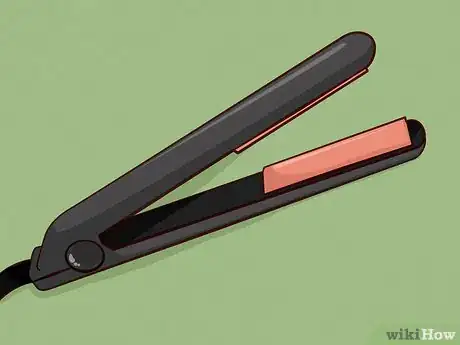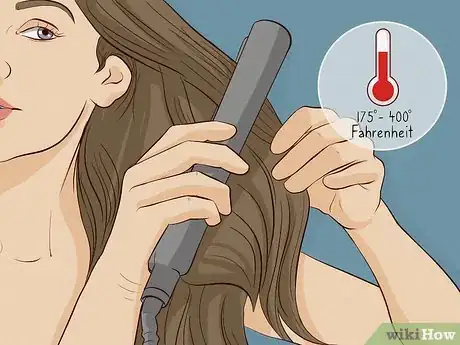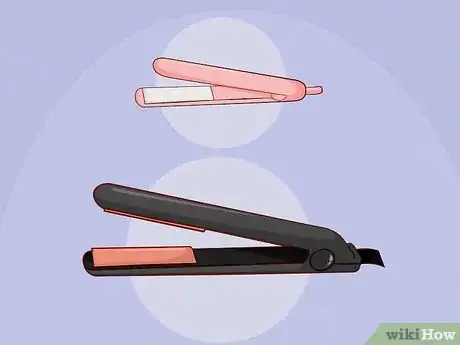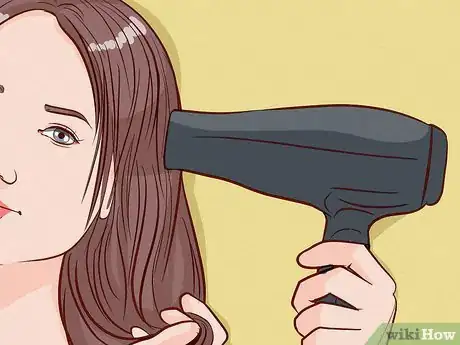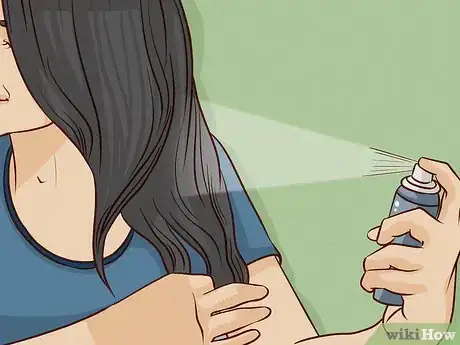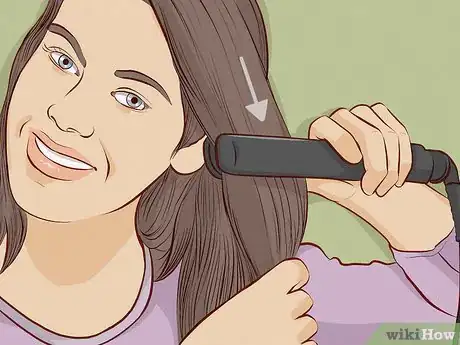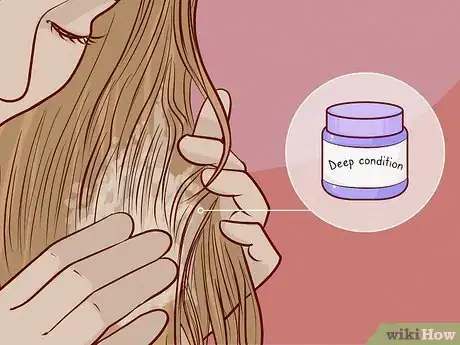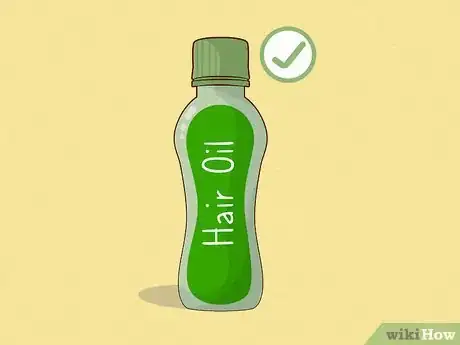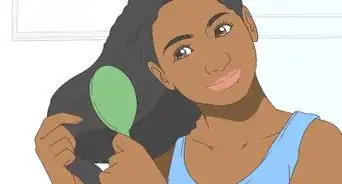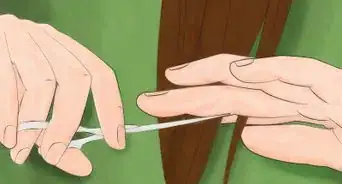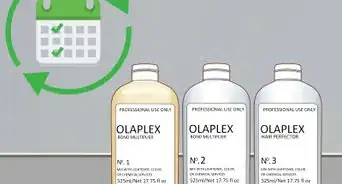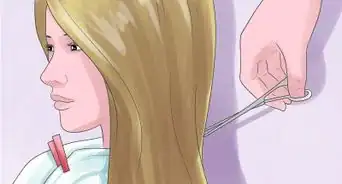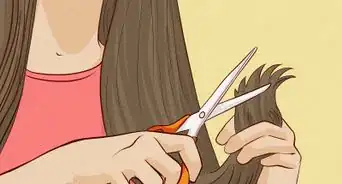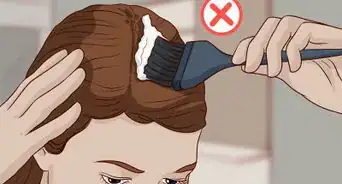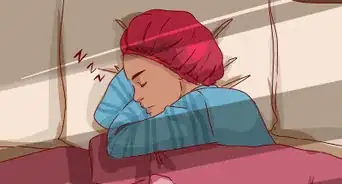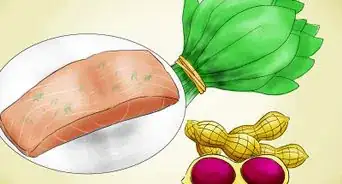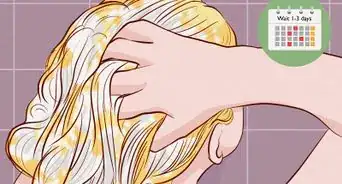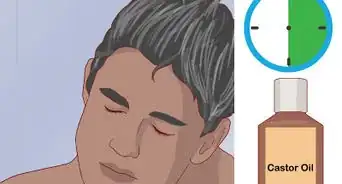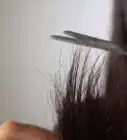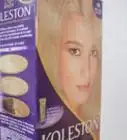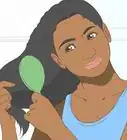This article was co-authored by Michael Van den Abbeel. Michael Van den Abbeel is a Professional Hair Stylist and the Owner of Mosaic Hair Studio and Blowout Bar in Orlando, Florida. He has been cutting, styling, and coloring hair for over 17 years. Michael loves showing his clients how to wash and wear their hair easily and effortlessly. Mosaic Hair Studio and Blowout Bar is recognized as a Diamond Top Tier level Wella salon.
wikiHow marks an article as reader-approved once it receives enough positive feedback. In this case, 86% of readers who voted found the article helpful, earning it our reader-approved status.
This article has been viewed 326,461 times.
A curling or straightening iron can help give your hair the ideal texture for whatever look you're going for. Unfortunately, using one everyday can do serious damage to your locks. If you can't give up your favorite heated styling iron, though, there are ways to minimize the damage. By using the right type of iron, using it properly, and treating your hair with product that will help strengthen it, you can keep your tresses as healthy as possible.
Steps
Choosing an Iron
-
1Use an iron made of a high quality material. If you’re going to use a straightening or curling iron on your hair daily, it’s important that to select one that’s made with a material that will do the least damage to your hair. Inexpensive irons are usually made with metal that doesn’t heat evenly so it can easily burn your hair. You'll pay more for an iron made with a higher quality material, but it will help minimize damage.[1]
- Ceramic irons heat quickly and evenly, so they’re not as likely to burn your hair. They also produce negative ions that help smooth cuticle and boost shine. Be sure to choose an iron that’s made of ceramic and not just coated with it. A ceramic coating will eventually wear off over time.
- Tourmaline irons can produce 6 times the amount of negative ions that ceramic models do. As a result, you’re left with smooth, shiny, healthy looking hair.
- Titanium irons are usually the most expensive, but they heat quickly and evenly. They’re a particularly good option for thick or coarse hair.
-
2Opt for an iron that has adjustable temperature controls. Many straightening and curling irons only have low, medium, and high heat settings. To keep your hair from getting damaged, you want to use the lowest heat possible to give you your desired style. That’s why it’s best to purchase an iron with digital heat controls that allow you to choose a specific temperature to heat to.[2]
- In general, an iron that allows you to set the temperature between 175 degrees to 400 degrees Fahrenheit (80 degrees to 200 degrees Celsius) is sufficient for all hair types.
- The finer or thinner your hair is, the lower the temperature on your iron should be. Start at 175 degrees (80 degrees Celsius), and only raise the temperature if your hair isn’t curling or straightening properly.
- No matter how thick or coarse your hair is, you should never set your iron to higher than 400 degrees Fahrenheit (200 degrees Celsius).
Advertisement -
3Consider the size of your iron. The size of your straightening or curling iron can also affect how damaged your hair becomes. If you use a larger iron, you’re less likely to need to go over the same section of hair twice to curl or straighten it properly. In general, a 1-inch (23-mm) curling or straightening iron is the most versatile for all hair types.[3]
- If you have a shorter hair, you may want to use a smaller iron.
- If you have extremely thick or long hair, you may want to use a larger iron.
- When it comes to curling iron, it’s also important to consider the hairstyle that you’re going for. If you want tight ringlet curls, you’ll want to use a smaller curling iron. If you want loose waves, you’ll want to use a larger curling iron.
Using Your Iron
-
1Dry your hair completely. Before you use any type of iron on your hair, it’s crucial that you dry it first. If your hair is wet when you apply heat to it, you will literally boil the moisture out of it and do serious damage. Allow your hair to dry completely before you pick up your iron.[4]
- Because you’ll be applying heat to your hair with the iron, it’s best to air dry your hair before styling it. Using a blow dryer on your tresses means that you’ll be treating it with a double dose of heat, which can do more damage.
-
2Apply a heat protectant. Before you use your curling or straightening iron, you want to protect your hair so it won’t lose too much moisture from the heat. Work a heat protectant product through all of your hair -- it will coat your locks so they don’t lose their natural moisture.[5]
- For fine or thin hair, a heat protectant spray is usually the best option.
- For thick or coarse hair, a heat protectant oil, cream, or lotion is usually the best option.
- Look for a heat protectant that contains humectants, such as panthenol and propylene glycol, to lock in moisture, and silicones, such as amodimethicone and dimethicone, to provide insulation from the high temperatures.[6]
- When you’re curling or straightening your hair, it’s a good idea to use a heat protectant product that also has some hold to it so you can lock in the curls or straightness.
-
3Heat each section of hair briefly. If you leave the iron on any one section of hair for too long, you run the risk of burning it. To avoid damage, never leave the curling or flat iron on a single section of hair for more than 3 to 5 seconds.[7]
- When you’re straightening your hair, be sure to keep the iron moving over to avoid heating any one spot for too long.
Repairing Damage
-
1Use a moisturizing shampoo. Heat styling with an iron strips your hair of the natural moisture that keeps it healthy. To keep your hair hydrated, switch to a moisturizing shampoo that will clean your locks while also delivering moisture-rich ingredients. Look for a formula that contains natural oils such as argan or coconut.[8]
- Be sure to use a sulfate-free shampoo. Sulfates help create lather for shampoos, but they’re also very drying.
-
2Deep condition your hair weekly. While you should use a traditional conditioner each time you shampoo your hair, it’s also important to deliver a more intense dose of hydration at least once a week. Using a deep conditioner or a hair mask, which contains hydrating ingredients such as argan oil, coconut oil, shea butter, and keratin, can help keep your hair moisturized even if you heat style everyday. Apply it once a week for the best results.[9]
- Consult the instructions on the deep conditioner’s packaging to determine the correct way to use it. Most formulas require putting in on wet, freshly shampooed hair and allowing it to sit for 20 to 30 minutes before washing it out.
- If you have extremely dry, thick, or coarse hair, you may want to use the deep conditioner every time that you wash your hair.
-
3Moisturize your hair with oil. Both traditional and deep conditioners are washed out of the hair, so their moisturizing effects don’t always last all day. After you wash your hair, apply a hair oil to your locks to keep them hydrated throughout the day.[10]
- Squeeze several drops of the oil into your palm, and rub it between your hands. Gently smooth the hands over your hair and work the oil through your entire head.
- If you have fine or thin hair, rosemary and pomegranate seed oils are good options.
- If you have thick or coarse hair, avocado, coconut, and olive oils are good options.
-
4Get regular trims. The ends of your hair are the spot that’s going to show the damaged from heat styling the most quickly with spilt ends and breakage. By getting your hair trimmed every 6 to 8 weeks, you’ll remove the damaged hair so your locks look healthier overall.[11]
- When you get your hair cut, it’s a good idea to ask your stylist for tips on keeping your hair healthy. She might be able to provide tips for using irons on your particular type and style of hair, so you can minimize damage.
Expert Q&A
-
QuestionHow do you prevent heat damage when straightening hair?
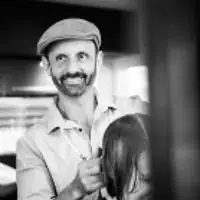 Michael Van den AbbeelMichael Van den Abbeel is a Professional Hair Stylist and the Owner of Mosaic Hair Studio and Blowout Bar in Orlando, Florida. He has been cutting, styling, and coloring hair for over 17 years. Michael loves showing his clients how to wash and wear their hair easily and effortlessly. Mosaic Hair Studio and Blowout Bar is recognized as a Diamond Top Tier level Wella salon.
Michael Van den AbbeelMichael Van den Abbeel is a Professional Hair Stylist and the Owner of Mosaic Hair Studio and Blowout Bar in Orlando, Florida. He has been cutting, styling, and coloring hair for over 17 years. Michael loves showing his clients how to wash and wear their hair easily and effortlessly. Mosaic Hair Studio and Blowout Bar is recognized as a Diamond Top Tier level Wella salon.
Professional Hair Stylist The easiest way to prevent heat damage to your hair is to turn down the temperature on your flat iron.
The easiest way to prevent heat damage to your hair is to turn down the temperature on your flat iron. -
QuestionWhy do I get split ends?
 Community AnswerYou get split ends over time due to damaged hair. Even healthy hair will get split ends.
Community AnswerYou get split ends over time due to damaged hair. Even healthy hair will get split ends. -
QuestionI am straightening my hair on a daily basis . I am using a heat protection serum before ironing. Will the iron affect my hair badly?
 Community AnswerIt's important to use a heat protectant every time you straighten your hair because it will limit the damage. However, straightening everyday isn't a good idea and will usually leave you with drier, more brittle hair.
Community AnswerIt's important to use a heat protectant every time you straighten your hair because it will limit the damage. However, straightening everyday isn't a good idea and will usually leave you with drier, more brittle hair.
Warnings
- While these tips can keep your hair as healthy as possible, using a curling or flat iron daily will still cause some damage. It’s best to only use an iron one to two times per week.⧼thumbs_response⧽
- Never leave a hot iron unattended, and always turn off and unplug your iron when you’re done using it.⧼thumbs_response⧽
- Be careful using irons or blow dryers near your scalp. If held too close, they may irritate or burn your skin.⧼thumbs_response⧽
Things You'll Need
- A good quality curling or flat iron
- A heat protectant
- Moisturizing shampoo
- Deep conditioner
- Hair oil
References
- ↑ http://www.folica.com/hair-101/buying-guides/flat-iron-guide/
- ↑ http://www.today.com/style/hair-damage-heat-styling-it-really-bad-t17746
- ↑ http://stylecaster.com/beauty/the-5-rules-of-heat-styling-your-hair/
- ↑ http://www.huffingtonpost.com/2014/03/25/flat-iron-tips-hair-damage_n_5024242.html
- ↑ http://stylecaster.com/beauty/the-5-rules-of-heat-styling-your-hair/
- ↑ http://www.curlynikki.com/2014/09/preventing-heat-damage-selecting.html
- ↑ http://www.webmd.com/beauty/features/how-not-to-wreck-your-hair#2
- ↑ http://www.today.com/style/hair-damage-heat-styling-it-really-bad-t17746
- ↑ http://www.today.com/style/hair-damage-heat-styling-it-really-bad-t17746
About This Article
Using an iron on your hair daily can do serious damage to your locks, but you can minimize the damage and keep your hair healthy by using your iron properly. Start by drying your hair completely to avoid literally boiling the moisture out of your locks. Once your hair is dry, apply a heat protectant to lock in the natural moisture. Then, as you run the iron through your hair, make sure to not linger on any one section for more than 3 to 5 seconds to avoid burning your locks. If you notice that your hair is becoming more dry or brittle, use a moisturizing shampoo to keep your hair well hydrated. To learn how to repair damaged hair with a deep conditioner, keep reading!
